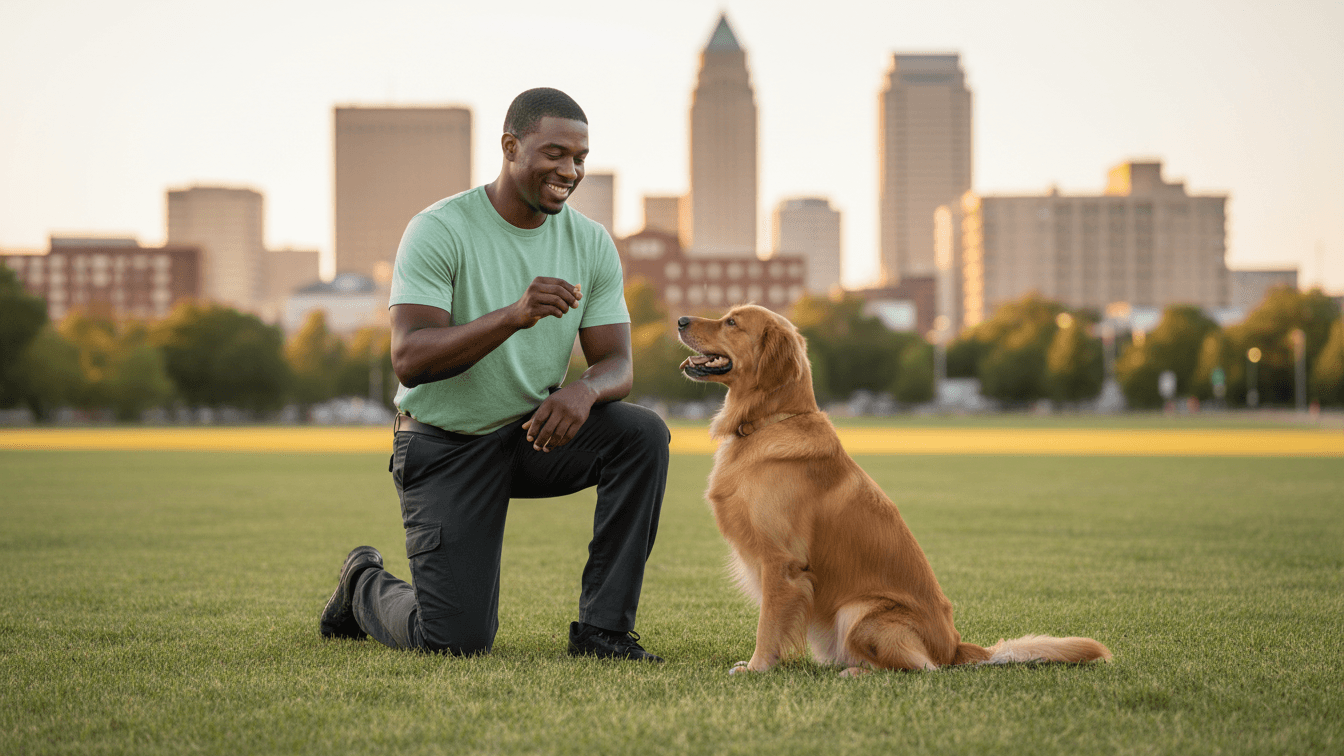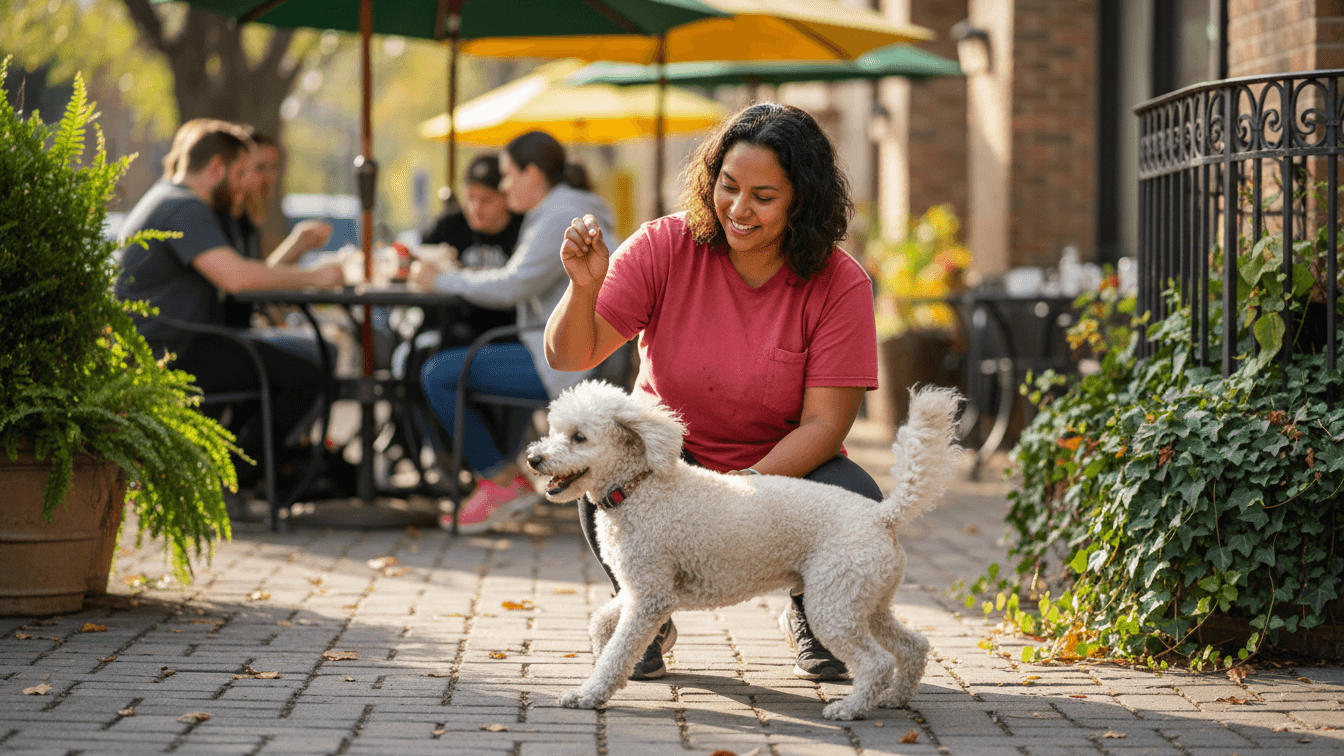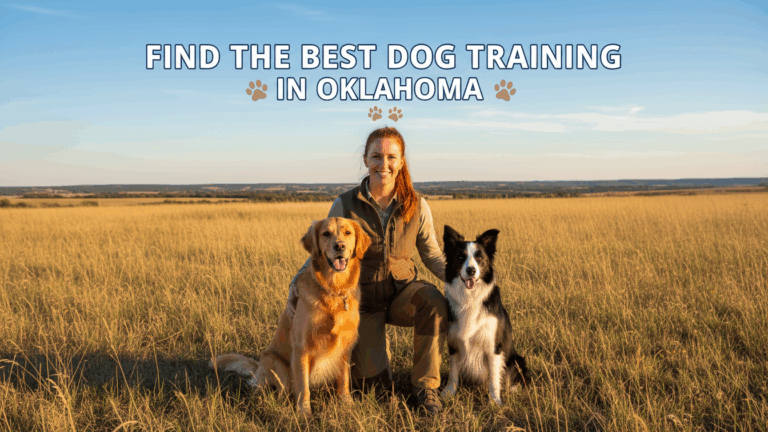Your Complete Guide to Choosing a Dog Trainer in Oklahoma
Living with a dog in Oklahoma means dealing with unique challenges, from hot summers that limit outdoor training time to the need for solid recall skills in wide-open spaces. Whether you’re near bustling Oklahoma City neighborhoods like Midtown or Edmond, or in quieter communities across the state, your dog needs to handle everything from crowded farmers markets to encounters with local wildlife.
Oklahoma doesn’t regulate dog trainers at the state level, which means the quality of training services can vary widely. When you find a professional dog trainer who uses science-based methods and understands Oklahoma’s specific requirements, you’ll get better results both at home and out in your community.
How to Choose the Right Trainer
Start by looking for someone who uses positive reinforcement training and can set realistic goals for your Oklahoma lifestyle. This means your dog should learn to walk calmly through busy parks, stay focused around unfamiliar dogs, and handle vet visits without drama.
Credentials give you a quick way to compare trainers’ experience levels. Common dog trainer certifications include KPA-CTP, CPDT-KA, or IAABC-CDBC for behavior problems. If your dog has serious aggression issues, look for someone with CBCC-KA or a science-based program like CTC.
In-home dog training works great for puppy manners, door greetings, and neighborhood leash skills. Group classes make sense once your dog can focus around other dogs, especially before you try busy spots like Lake Hefner or Scissortail Park.
Ask about the trainer’s experience with Oklahoma-specific challenges like storm anxiety, which affects many dogs in this region. A good trainer will help you build coping skills before severe weather season hits.
Common Dog Training Methods Explained

Reward-based methods build the trust you want while creating lasting behavior changes. They also help you follow Oklahoma’s local ordinances about keeping dogs under control in public.
Basic obedience covers sit, down, stay, place, recall, and leash training so your dog can handle walks, restaurant patios, and park visits without pulling or jumping on people. These skills become the foundation for everything else your dog will learn.
Puppy training focuses on socialization, potty training, bite control, crate comfort, and early leash work. Starting with short, positive training sessions prevents bad habits from forming in the first place.
Behavior modification addresses fear, reactivity, resource guarding, or separation anxiety through careful desensitization and counterconditioning. For serious cases, ask if your trainer works with local veterinarians who understand behavior issues.
Private lessons and coaching let you customize everything around your daily routines, while day training can speed up results when you’re short on time. Some trainers will work your dog during the day and then teach you how to maintain the skills.
Dog training classes help your dog practice good manners around other dogs and people. The best classes give dogs plenty of space, screen participants carefully, and teach calm behavior rather than just excitement.
Specialized programs like therapy dog training or service dog training require extra structure, public-access skills, and a very clear step-by-step training program. Oklahoma law protects service dogs, so proper training matters both for your dog’s success and for maintaining public access rights.
Stay away from trainers who use fear, intimidation, or pain to get results. Humane methods are safer for everyone, easier to maintain long-term, and much better for keeping peace with your neighbors.
Average Cost of Dog Training in Oklahoma (Updated for 2025)
Prices across Oklahoma depend on the trainer’s experience, how long sessions last, and where the training happens. Metropolitan areas like Oklahoma City and Tulsa tend to run slightly higher than smaller towns, but quality training is available throughout the state.
| Service Type | Average Cost (Oklahoma) |
|---|---|
| Puppy classes (4-6 weeks) | $120-$250 total |
| Group obedience classes (4-6 weeks) | $130-$280 total |
| Private lessons (60-90 min) | $90-$170 per session |
| In-home coaching packages (4-6 visits) | $380-$850 total |
| Day training (trainer works your dog + handoff) | $400-$900 per week |
| Behavior consult for reactivity/anxiety (initial) | $125-$225 |
| Board and train (2-4 weeks) | $1,800-$4,200 total |
You’ll probably pay extra travel fees for trainers who need to drive longer distances, especially in rural areas. Expect higher rates for complex behavior work or aggressive dog training that requires specialized skills.
Make sure you understand what’s included, how the trainer tracks progress, and whether they offer a free consultation or free evaluation before you sign up. Many expert dog trainers will meet with you first to assess your dog’s needs and explain their training program.
Questions to Ask a Potential Dog Trainer
- What training methods do you use, and how do you keep training sessions positive and low-stress?
- What credentials do you have, like KPA-CTP or CPDT-KA? Do you keep up with continuing education such as CPDT-KSA?
- How will you customize the training plan for my dog’s specific needs and our Oklahoma lifestyle?
- Do you offer in-home visits, group classes, or day training, and which approach fits my goals best?
- Have you worked with dogs who have storm anxiety or other Oklahoma-specific challenges?
- How will we measure my dog’s progress and know when to add more distractions?
- What are the total costs, including any travel fees, and what’s your cancellation policy?
- Do you carry liability insurance, and can you show me proof?
- For behavior problems, will you work with my veterinarian if needed?
- What should I practice between our sessions to help my dog keep improving?
Local Oklahoma Rules and Considerations
Oklahoma gives cities and towns control over most pet regulations, which means rules can vary significantly depending on where you live. Understanding these local requirements helps you train your dog to be a well-behaved companion in your specific community.
Most Oklahoma cities require leashes in public spaces except inside designated dog parks. Check your local ordinances for specific length requirements, but a standard 6-foot leash works in most areas.
Oklahoma state law requires current rabies vaccination for all dogs over four months old. You must have proof of vaccination available, and many cities require you to display a current rabies tag on your dog’s collar.
Some municipalities have breed-specific regulations or restrictions on certain dogs, though these laws vary widely across the state. Check with your city’s animal control office for local requirements.
Excessive barking can be considered a nuisance under most city ordinances, so work with your trainer on alert barking and separation anxiety before neighbors start complaining. Many noise ordinances are enforced based on complaints, making good training a practical necessity.
Oklahoma doesn’t require special licenses for dog trainers at the state level. If a business boards dogs for payment as part of a board and train program, they may need to follow facility and health requirements, but these vary by county.
Liability insurance isn’t legally required for dog trainers in Oklahoma, but professional trainers should carry it anyway. Always ask to see proof of coverage before signing up for dog training services.
Local Oklahoma Resources for Dog Owners
These spots give you great places to practice polite manners, work on recalls, and provide safe enrichment for your dog. Always follow the posted rules and etiquette guidelines.
- Biscuit Acres Dog Park in Oklahoma City offers separate areas for large and small dogs with plenty of space for recall practice during quieter times.
- Joe B. Barnes Regional Park Dog Park in Oklahoma City provides fenced areas where you can work on socialization and off-leash training skills safely.
- Hunter Park Dog Park in Tulsa features separate sections for different dog sizes and gives you a controlled environment for building confidence around other dogs.
- Lake Thunderbird State Park welcomes leashed dogs on trails and in most outdoor areas, making it perfect for working on focus around wildlife and other park visitors.
- Oklahoma City Animal Welfare offers resources on licensing, lost pets, and community programs throughout the metro area.

FAQs
How much does in-home dog training cost in Oklahoma?
Most Oklahoma trainers charge $90-$170 per in-home visit, with discounts available when you buy packages. Behavior problems or specialized training for dogs typically start at the higher end of that range.
Is in-home dog training worth it?
Absolutely, because you’re working on problems exactly where they happen. Your trainer can fix door manners, jumping on guests, counter-surfing, and yard reactivity right at home, then step outside to practice leash skills on your actual neighborhood sidewalks.
Can you pay someone to house train your dog?
Yes, many trainers offer puppy training programs that include potty training, crate routines, and daily schedules. Day training can speed up the process while teaching you how to maintain the progress.
What is the 3-3-3 rule for dog training?
This is a helpful timeline for new or adopted dogs: expect about 3 days for your dog to decompress, 3 weeks to learn your routines, and 3 months to feel completely settled. Good training programs work with this natural adjustment period.
How long will it take to reach my training goals?
Most puppies and friendly adult dogs show solid progress within 4-8 weeks if you practice daily. Fear, reactivity, or aggression typically requires several months of careful behavior modification with gradual increases in difficulty.
What should I bring to group classes?
Pack a flat collar or harness, a 6-foot leash, high-value treats, water, and current vaccination records if your trainer requests them. Leave retractable leashes at home for safety reasons.
What’s the leash law in Oklahoma?
Leash laws vary by city and town throughout Oklahoma. Most municipalities require dogs to be leashed and under control in all public areas except inside designated off-leash dog parks. Contact your local animal control office for specific requirements in your area.
Do I need a dog license in Oklahoma?
Dog licensing requirements vary by city. Some Oklahoma cities require annual licenses while others don’t. Contact your local animal control or city clerk’s office to find out what applies in your area.
What shots does my dog need in Oklahoma?
Oklahoma state law requires rabies vaccination for all dogs over four months old. Your veterinarian may also recommend distemper-parvo, bordetella, and leptospirosis based on your dog’s lifestyle and exposure risks.
Are dog trainers required to be licensed in Oklahoma?
No special trainer licenses exist in Oklahoma at the state level. Trainers follow normal business regulations, but if they offer boarding services as part of their programs, they may need to follow county facility requirements.
Where can I practice off-leash recall in Oklahoma?
Use fenced dog parks to keep things safe and legal. Try visiting during quieter hours when you’re starting out so your dog can focus better without too many distractions.
Which dog parks allow training around Oklahoma?
Most Oklahoma dog parks welcome training within their fenced areas. Popular options include Biscuit Acres and Joe B. Barnes Regional Park in Oklahoma City, and Hunter Park in Tulsa. These parks provide safe spaces for working on socialization and recall skills.
What trails allow dogs for training in Oklahoma?
Many Oklahoma state parks welcome leashed dogs on trails, including Lake Thunderbird State Park, Roman Nose State Park, and Red Rock Canyon State Park. These trails are perfect for teaching calm focus around wildlife, other hikers, and natural distractions. Always check current park regulations before visiting.
How do I help my dog with storm anxiety?
Many Oklahoma dogs struggle with storm anxiety due to frequent severe weather. Work with a certified dog trainer who understands desensitization protocols. Start training well before storm season, create a safe space in your home, and consider working with your veterinarian if anxiety is severe.
What if my dog is reactive to other dogs?
Reactivity is common and treatable through careful behavior modification. Look for a trainer experienced with counterconditioning who can create a gradual exposure plan. Private lessons work better than group classes initially, and you’ll need to practice regularly in controlled environments before trying busy public spaces.
The right combination of thoughtful planning, humane methods, and consistent practice around Oklahoma’s parks and neighborhoods will help your dog become a confident, well-behaved companion. If credentials matter to you, don’t hesitate to ask about dog trainer certifications and how your trainer stays current with new techniques.
